 zachary harden
zachary harden
Keywords: ufe | unidentified flags | 2013 |
Links: FOTW homepage | search | disclaimer and copyright | write us | mirrors

Last modified: 2025-02-07 by  zachary harden
zachary harden
Keywords: ufe | unidentified flags | 2013 |
Links: FOTW homepage |
search |
disclaimer and copyright |
write us |
mirrors
Please note our Policy for Submissions and Enquiries.
Below is a series of images of flags that have been provided to FOTW; some we have recognized, and some we have been unable to recognize. If you can help us identify any of these flags, please let us know! Contact the: UFE Editor.
Identification Key:
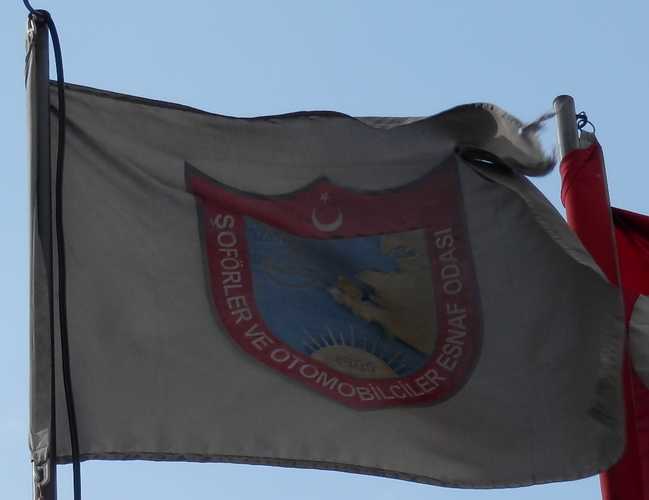 Image from Klaus-Michael Schneider, 1 May 2014,
Image from Klaus-Michael Schneider, 1 May 2014,
Perhaps the Chamber of Crafts of Drivers and Vehicles(?) or Chamber of Drivers and Mechanics(?) - in Turkish: Sofõrler ve Otomobilciler Esnak Odasi - probably branch or member of Turkish Drivers and Vehicles Federation(?) (Turkish: Türkiye Soförler ve Otomobilciler Federasyonu).
The flag is white with the logo in its centre. The name of the organization is on the red bordure of the logo.
See also Türkiye Sofõrler ve Otomobilciler Federasyonu (in Turkish).
Klaus-Michael Schneider, 1 May 2014
Esna Odasi means "tradesmen". Judging by the map it also should say Izmir somewhere. Each chamber has its own flag, By the way, offering scope for flag ferreting.
Peter Hans van den Muijzenberg, 1 May 2014
This can be seen better in this photograph, where it can be seen that the lower grey bit in the emblem in Michael's image is a steering wheel symbol, and the upper bit, hidden in part by the fold, is the mention of the city. This specimen does not have the grey border around the emblem, however. on the other hand, the 1965 is clearly readable here.
Peter Hans van den Muijzenberg, 2 May 2014
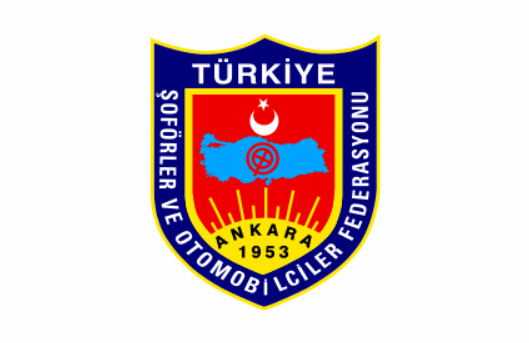 Image located by Esteban Rivera, 19 January 2016
Image located by Esteban Rivera, 19 January 2016
Reviewing comments made by Klaus-Michael Schneider regarding this entry, I believe it is the TSOF (shedTürkiye Soförler ve Otomobilciler Federasyonu - Turkish Drivers and Automobiles Federation), which is an association of professional commercial drivers. Since it is a Federation, then several chapters exist throughout the
country, like the Kocaeli, established in 1953), Mut, established in 1970), etc. The flag in question is the Izmir Chapter of TSOF. The TSOF was established on April 4, 1953. Both the TSOF and TSOF-Izmir then can be categorized as a union flag.
The flag of TSOF is seen (here) from this (source). For additional information go to the TSOF website.
Esteban Rivera, 19 January 2016
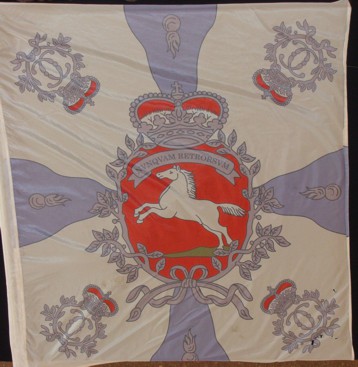 Image from Robert Leek, 21 April 2014
Image from Robert Leek, 21 April 2014
I live in Prince Edward County, Ontario, Canada, and am an amateur flag collector and retailer. Recently I was contacted by one of our local museums, enquiring about replacing a flag that is in their display collection. It has become frayed, and they wish to purchase a new one. They believe that the flag, pictures of which are attached, come from a small German settlement which arrived some time ago. Specifically, they believe that this flag was carried to Canada by Hessians in the 18th Century, so this may have some military significance. In any event, I was wondering if you would be able to identify the origin of this flag, or suggest contacts who could help.
Robert Leek, 21 April 2014
At the first glance it seems to be the reprint of a Brunswick infantry colour, in this case probably a colonel's colour due to the white background, used either by the 1st company or later on by the 1st battalion. The motto and the horse forcene with basement (which might have been white or green on the original colour) match my hypothesis. About the cypher (a double "C") I have no idea. You might take a look at the War Flags website; Your flag is not listed there, but you will find evidence to other Brunswick military colours.
Klaus-Michael Schneider, 22 April 2014
Thank you for your quick and most interesting response. I will share this with the museum in possession of the banner. I imagine that they will wish to conduct their own research, and would probably like to reproduce the banner as well (at some expense, I would imagine). If you discover anything further (The double "C"" for example), please continue to share.
Rob Leek, 22 April 2014
In case of Brunswick the Colonel´s Colour is later called Duke's Colour.
Klaus-Michael Schneider, 22 April 2014
This looks like a modern reproduction of an eighteenth-century colour of an infantry regiment from Brunswick-Wolfenbüttel. Information on the colours of Brunswick regiments during this period is fragmentary, but the flag in the photo most closely resembles the colonel's colour (Leibfahne) of the von Riedesel Regiment. However, the colour of the field is normally given as yellow, and the flames are usually depicted as a slightly darker blue. The C, doubled and reversed, is the cipher of Duke Carl, who reigned from 1734 until 1780. The cipher and wreaths should all be silver. The other colours of the regiment were in the reverse colours - blue with yellow wavy 'flames'.
The regiment served in North America during the War of Independence, and was captured at Saratoga. Although the colours were supposed to be surrendered, members of the regiment hid them from their captors and returned them to Germany.
Sources: Wikipedia on von Riedesel and the Saratoga campaign.
Perhaps the community was formed originally from some veterans of the regiment, who chose to remain in Canada rather than return to Europe. A group has recreated the Von Riiedesel Regiment.
The original colour would be painted silk, but I came across a printed polyester version at Universalhandel24. (other flagmakers are available!)
Ian Sumner, 23 April 2014
Your comment again is very helpful, and confirms my supposition. As I haven't enough knowledge about Brunswick military colours, I didn't dare to speculate about the yellow colour. It would be more helpful, if Rob Leek could provide us with a photo of the original flag, which is to be restored in the museum mentioned by him.
Neubecker (1939) displays a similar colour, black with yellow flames and dates it 1780 (Regiment Prinz Friedrich).
Now the things I want to know:
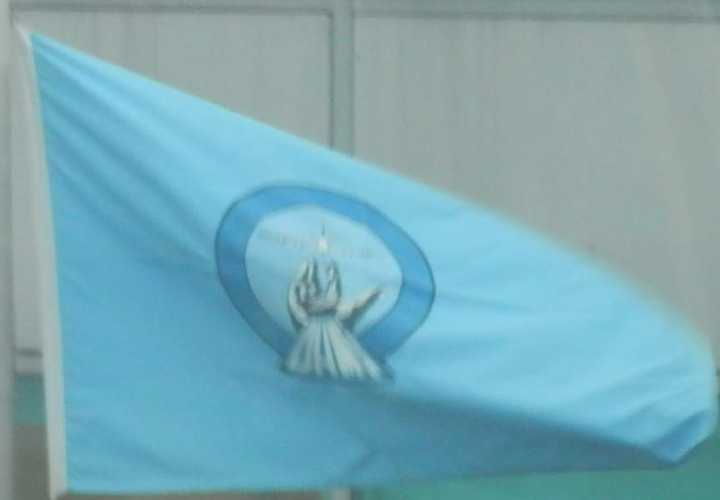
This flag is now positively identified as that of the Directorate General of State Airports Authority and located in the FOTW database.
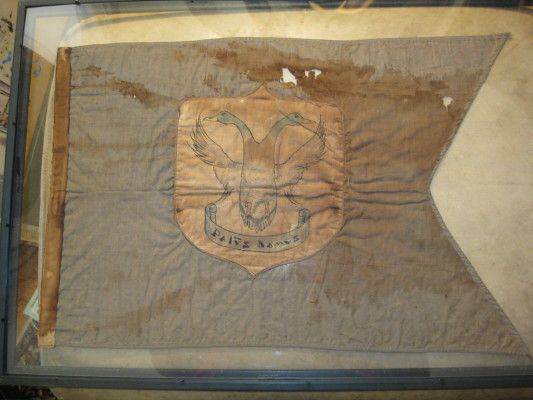
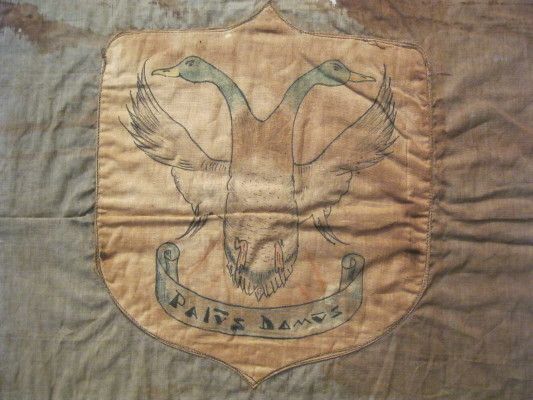
Images from Dave Martucci, 3 June 2014
I have been asked to comment on this supposedly CSA flag, which I very much doubt. But I have never seen anything like it. The motto is either Palus Damus or Paius Damus or Palvs Damvs (next to last letter in each word is constructed as a "V" with a horizontal line over it, perhaps Palus Damus. Google translate says it is Lithuanian meaning "Ladies of Palus" but that doesn't make any sense either as there is no city of that name in Lithuania (there is a Palus in Finland, but never mind).
The owner says: "Others have looked at it that are flag experts and they all agree it is Civil War era, but one super expert/dealer who has only seen the pictures said it was a fake within minutes of my sending him the pictures. He did not send me through his procedures nor charge anything, but he did tell me that I was was stupid and shouldn't get ripped off and should stay away from auctions.
As far as other opinion's, what was most striking was Dan's (from Michigan) who I have know for quite some time now, and who has dealt strictly in flags for a few decades, said that the color and size of the guidon jumped out at him and his first response was 'Louisiana' and Civil War, but these are ducks, not pelicans. Still, this was his impression. I do not know if it is wool or cotton, it is not silk. Roger Dary said it was Civil War, and I have seen him point out details about flags that other 'Flag Experts' have missed, insane details that belie his opinion.
As to it being from Louisiana, the guidon may have been made or imported through New Orleans. I don't know, but I am researching the emblem and motto, Palus Domus (Swamp Home) in Latin, and possibly (Rally Round the Flag 'pole'") in German, but am having little luck. Though, it appears that if it is Civil War, it is Confederate, as it was pointed out to me by the State of Ohio Historic Society Museum (and Flag) curator, that most all Union flags were in the national colors. I thought it might be from the Kankakee Swamp of Great Black Swamp of northern Ind/Ohio, but found no supporting evidence other than some fiction writers who named one of the imaginary countries in their sci-fi series Domus Palus, and they were from Indianapolis, Indiana.
However, if it is Confederate, there are thousands of swamps up and down the Mississippi and into the interiors of Arkansas, Texas, Louisiana, Mississippi and Alabama, not to mention Florida and the Great Dismal Swamp on the N. Carolina/Va border. A lot of ground to cover to be sure. This guidon came out of a midwest collection with a number of Civil War swords and guns."
Dave Martucci, 3 June 2014
Looks like a yacht club flag, as to time period, hard to say from the pictures. What is the evidence that its Civil War period from those who say it is and is it the American Civil War or some other?
Tom Martin, 3 June 2014
I have high doubts that it is anything Confederate at all. The ducks with the twin heads and the interesting slogan underneath suggest something European to me. There are European battle flags that have similar bird designs with the twin heads - Prussian I think - and with different types of birds?
Greg Biggs, 3 June 2014
At this point, you know almost everything I know. I don't see the evidence. I do have some closeups of the hem and header but there is nothing special there. It is all somewhat poor machine stitching and the fabrics look like late 19th-early 20th century cotton bunting to me (but it is always hard to tell from photos).
As to the CW connection, I think it is pure guesswork and, of course, it must be CSA because it obviously isn't USA. Huh?
Dave Martucci, 4 June 2014
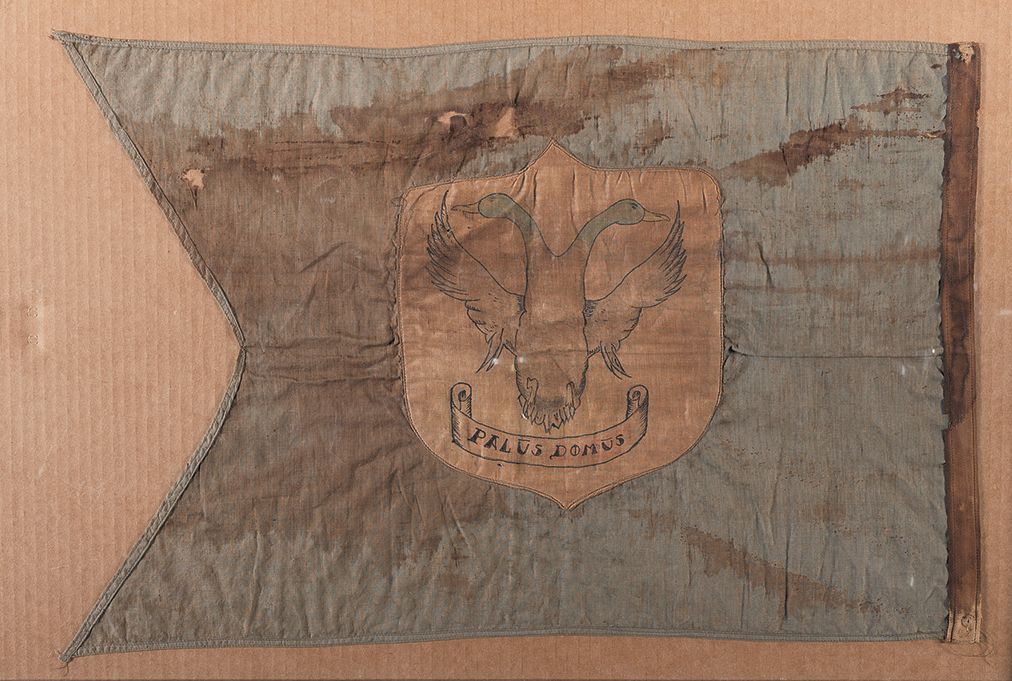 Image from Rock Island Auction
Image from Rock Island Auction
The flag came with a sword in the Rock Island auction. Could the sword be a clue? Contrarian that I am, "Swamp Home" fits to me along with the two headed duck as something Americana. The shield and duck are on both sides apparently, this to me is interesting, almost like it designates an actual physical place, like maybe a plantation.
Al Sumrall, 3 June 2014
I was unaware of this page and the photo of the reverse. The motto on the reverse is in a slightly different style, showing as Palus Domus for sure. It is claimed to be Latin, but Latin doesn't use diacritical marks, so that seems off to me. With the correction of characters, Google Translate now says it is Latvian for "Large Thoughts" (literal: "Pile of Thought"). This seems like a motto to me.
The lady next door was born in Latvia and speaks it fluently (she was born in Riga the day the Russians entered in 1940 and her folks fled to Germany for safety!) and I will show her the flag and get her thoughts.
Dave Martucci, 4 June 2014
This just reinforces my belief that this flag has European connections and not American Civil War.
Greg Biggs, 4 June 2014
Palus is probably a pale, and the Latter Day Saints are organized in pales (here in Hamburg there is a "pale house". So it may be a Mormon flag in the end? Maybe I am completely wrong. But the duck is "really" odd.
Klaus-Michael Schneider, 4 June 2014
With the Latvia motto it just might be a World War I or World War II souvenir. I can't see the burgee having a CSA relationship, unless it has a Latvian duck dynasty connection.
Tom Martin, 4 June 2014
Although "At home in the floods/swamps" ("Palus Domus") would be very nice meanings, I don't think there's a language that translates both words that way, except when ignoring the suffixes.
Writing a dash over a u, to indicate it's an actual u, is a style that in some European countries was still taught in the first half of the 20th century. I don't know how this was in the US. It would seem quite appropriate for writing Latin, and this may have been its origin; it's not, however, limited to a specific language.
I don't think I've ever seen the that specific two-pointed shield shape before. It's a bit reminiscent of the Genoese shields.
The mallard can be found on all continents (with the possible exception of Antarctica). They are not usually two-headed, however. I would say that the only birds that are frequently observed to be two-headed are the eagles of the Holy Roman Empire and its Rus, German, and other descendent traditions. This mallard would appear to be a reference to those.
The scroll is placed under the mallard, but not below the shield. It would currently be somewhat unusual, but I don't know whether it's enough to select or exclude specific heraldic styles. Ideally the motto would be a positive expression and be related to the charge. This would seem to make bad Latin about a duck in the water more likely than a Latvian translation about a duck with great thoughts.
I don't know much about it; these are just some things to ponder. As far I'm concerned it may equally well be the flag or a Venetian regiment, a World War I impromptu American mockery of the Kaiser or a Baltic American immigrant's house flag to fly Home Swamp Home on his cabin.
Peter Hans van den Muijzenberg, 4 June 2014
Ducks from some swamps, right? Haven't you heard of a Swamp Duck? ![]()
Still would like some comment on that sword if possible.
Would an analysis of the material or ink bring anything to light?
Isn't the "O" in the DOMUS on the reverse a Greek "O" with that vertical line through it?
Maybe its in "Duck Latin"...sorry.
I agree it appears to have no American military hertitage at all with what is known unless it hung out over a restaurant or saloon.
Al Sumrall, 4 June 2014
Oh, the man from Buda. It does remind one of the pub or tavern signage used in the viking part world.
The only thing I know about swords is that the pointed end is the end you stab someone with.
Tom Martin, 4 June 2014
 Image from Rock Island Auction
Image from Rock Island Auction
It's described as a "Staff and Field Officer's style sword without scabbard" on the auction house website. Unfortunately, that is a fairly generic wire-wrapped saber, common in both Europe and North America in the 1800s, so no help there.
Pete Loeser, 4 June 2014
OCD kicking in and doing a lot of useless research, but I wonder if it could have been a masonic flag from Lithuania (ok, you win about the significant probability of the flag being Lithuanian). This might suggest a reason for it's survival and it's two headed birds (no ducks yet) are apparently found a lot in Masonry and not all the flags have complex symbols although maybe the flag has hidden ones (conspiracy theory angle). Lithuanian Freemasonry was extinguished by decree in 1827 so the symbols would be very rare today and it would be a collectors item in that milieu.
The owner might want to turn to the the Lithuanian Masons of today who could delve into Lithuanian Masonic history. Maybe it's survival is incidental to a Lithuanian who migrated the United States after/during the famine. The Lithuanian famine was in the late 1860's as you all know.
Suddenly I am getting deja vu like I wrote this before, this two headed duck is apparently getting to me, so I'd better put it out of my mind. Unfortunately I have a cat that quacks (it's name is Queenie, but my son nicknamed it Quackers because it quacks when petted) so the two headed duck will probably hang around in my head for a while...until the next mystery I cannot solve.
Al Sumrall, 5 June 2014
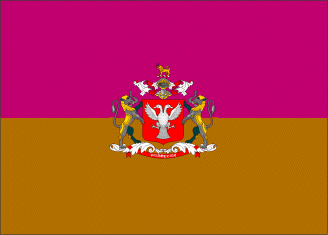 Image from James Dignan, 8 June 2014
Image from James Dignan, 8 June 2014
Amazingly, after never having seen a double-headed duck on a coat of arms, someone on the Facebook Flags of the World page has posted another one! The Indian city of Mysore also has that rather unusual emblem on its arms and flag.
James Dignan, 8 June 2014
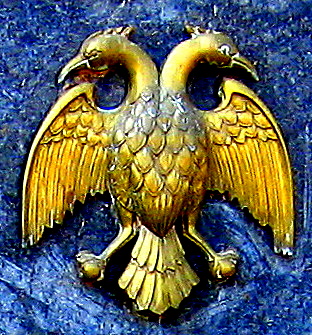 Image by Sarvagnya, 8 June 2014
Image by Sarvagnya, 8 June 2014
I found that the "double ducks" are actually from the "medieval" City of Karnataka. It is the Gandaberunda emblem found in the Mysore Palace and now the official emblem of the Karnataka state in India.
All this is rather "ducky", isn't it , but we still haven´t actually identified the flag in question. ![]()
Pete Loeser, 8 June 2014
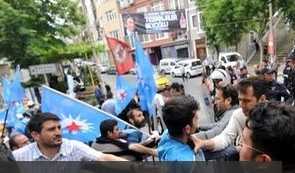 Image from Klaus-Michael Schneider, 4 June 2014
Image from Klaus-Michael Schneider, 4 June 2014
The shot was taken in Istanbul during a Rally against PM Erdogan. The light blue flags are in PKK style but not in PKK colours (celestial blue White red instead of green yellow red).
Source: Tagesschau (German TV News) 15 May 2014.
Klaus-Michael Schneider, 4 June 2014
This flag is of the Socialist Party of the Oppressed (Turkish: Ezilenlerin Sosyalist Partisi, ESP, Kurdish: Partiya Sosyalîst a Bindestan, PSB). It is a Kurdish-based Marxist-Leninist political party in Turkey. It defines itself as "a militant revolutionary socialist party fighting for a workers'-labourers' federative republic in Turkey and Northern Kurdistan." The party is one of the participants in the Peoples' Democratic Congress, a political initiative instrumental in founding the Peoples' Democratic Party in 2012.
Sources: Wikipedia and
the ESP Party website (in Turkish).
Zoltan Horvath, 4 June 2014
 Image from Esteban Rivera, 16 June 2014
Image from Esteban Rivera, 16 June 2014
In the Ministry of Defence of Iraq's official website, there's a video of reported captured terrorists who are conducting several attacks in the recent fighting in the country that led to the capture of Mosul, Tikrit and other cities by several armed movements, most notably the ISIS (or ISIL). In this video, there's supposed to be an Iraqi Army Infantry Unit flag in the background where these captured fighters are being interrogated. The flag [reverse side], seen in the background during the interrogation, follows the same pattern as a flag reported by Eugene Ipavec on December 27, 2010.
Esteban Rivera, 16 June 2014
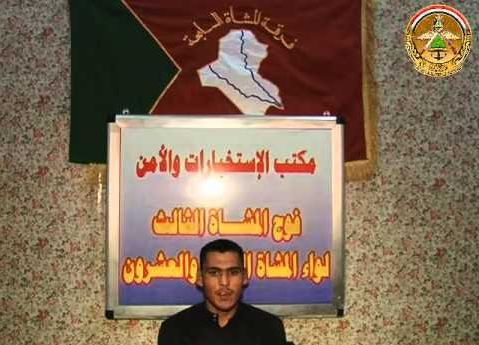 Image from Zoltan Horvath, 25 October 2014
Image from Zoltan Horvath, 25 October 2014
This is flag of Iraqi Seventh Infantry Division, the title is written above the Iraqi map on the flag. Here is another picture showing more of the flag.
Zoltan Horvath, 25 October 2014
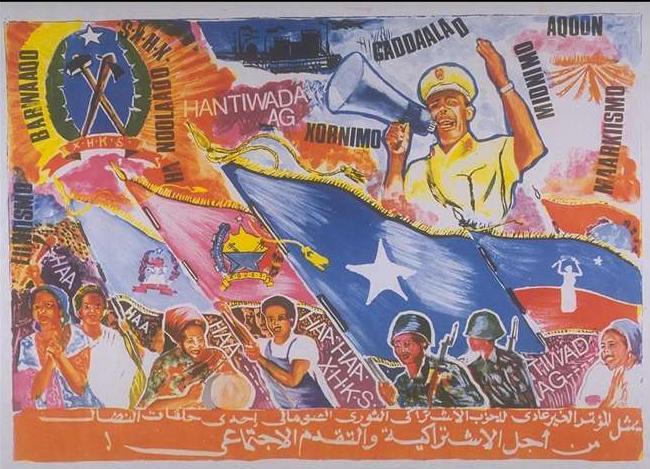 Image from Esteban Rivera, 21 June 2014
Image from Esteban Rivera, 21 June 2014
"The Somali Revolutionary Socialist Party (SRSP) ( in Somali: Xisbiga Hantiwadaagga Kacaanka Soomaaliyeed - XHKS - in Arabic: Al-Hizb Al-Ishtiraki Al-Thawri Al-Sumal) was the governing political party in Somalia from 1976 to 1991. It succeded the Supreme Revolutionary Council (SRC), which took control of the country after a coup d'Etat from 1969."
In this SRSP poster one can see four flags on the bottom. The only identifiable flag is the third flag (from left to right), the flag of Somalia . The other four flags are unidentified.
Sources: Supreme Revolutionary Council and the Supreme Revolutionary Council.
Esteban Rivera, 21 June 2014
Seems to be the flags of a single party, the youth brabch, the women brabch and the single Trade Union flag.
Jaume Ollé, 23 June 2014
There are words in latin script, plus there seems to be a caption in Arabic script. Do they mean anything?
- First one from the left [call it #43a]: Light blue, with an emblem consisting of a white and red "i-don't-know-what?", with a red scroll below it, and a wreath of what look like two differing halves around with at the top a white five-pointed star with a blue fimbriation.
- Second one from the left [call it #43b]: A lighter red field, with an emblem consisting of what looks like a sun with two crossed tools as in the party emblem, together wearing a pair of blue overalls, a yellow scrolls below it, and a wreath of dexter an arch of cogwheel and sinister "something else" with at the top a white five-pointed star fimbriated red.
- Third one from the left: Somalia.
- Fourth one from the left [call it #43c]: Blue over red, with a narrow white line between them, overall what looks like a white silhouette of female holding a broken rifle in the air, and further flyward in the blue a white five-pointed star.
- Fifth one from the left (in background) [call it #43d]: Red, a lighter and darker blue disk, possibly a globe, with dark purplish shapes along the delimiter of the disk.
All five flags have yellow fringes and tassels.
How can we describe the people associated with each flag?
Peter Hans van den Muijzenberg, 24 April 2015
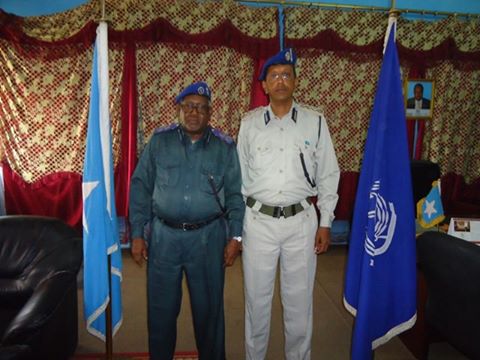 Image from Esteban Rivera, 21 June 2014
Image from Esteban Rivera, 21 June 2014
I've found this flag (on right), a Somali flag, most likely a Police flag. If anybody can identify it, please help.
Esteban Rivera, 21 June 2014
I have found a positive ID for UFE14-44. It is, as proposed by the submitter himself (Esteban Rivera), the flag of the Somali Police Force.
Daniel Lundberg, 4 July 2014
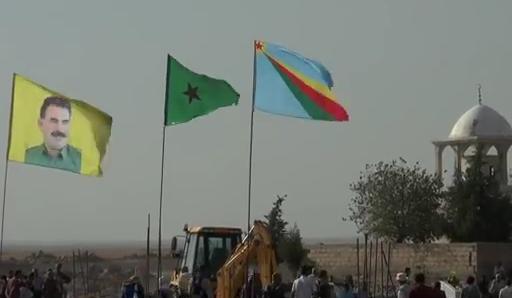 Image from Hoang Nhan Nguyen, 1 July 2014
Image from Hoang Nhan Nguyen, 1 July 2014
Help me to identify two flag on the image taken from the footage of VICE News.
Hoang Nhan Nguyen, 1 July 2014
Well, they're definitely Kurdish. The one on the left is a portrait flag of PKK leader Abdullah Ocalan. The middle one appears to be a variant of the green flag of its affiliate the KKK, but without the yellow sun on which the red star is usually placed. The right one is a novelty, but it has the KKK sun+star in the farthest corner of its canton.
Eugene Ipavec, 1 July 2014
I have several questions regargding that image: 1. Can you provide the original link of VICE news that Mr. Nguyen Hoang Nhan mentions? 2. I see an Abdullah Öcalan flag (first flag from left to right, like the ones post here as the Öcalan flag. It is possible that the other two flags may also be of Turkish origin, rather than Syrian, but do we have the location of where this picture was taken? Perhaps if we identify the place we may have a better chance of identifying the other two flags.
Esteban Rivera, 1 July 2014
The video you mention is taken on "Syrian Kurdistan or Western Kurdistan (Kurdish: Rojavayê Kurdistan), also commonly referred to as simply Rojava meaning the West in Kurdish, is a de facto autonomous region in northern and north-eastern Syria".
Regarding the flags in this video, they are the flags of the "Democratic Union Party (Kurdish: Partiya Yekîtiya Demokrat, PYD) is a Syrian Kurdish political party established in 2003 by Kurdish activists in northern Syria. An affiliate of the Kurdistan Workers' Party (PKK) and a founder member of the National Coordination Body for Democratic Change, it is described by the Carnegie Middle East Center as "one of the most important Kurdish opposition parties in Syria". It is said to control a number of towns in northern Syria." Sources: Democratic Union Party
The PYD "is basically ruling over the Northwestern part of the country. Since the start of the Syrian Civil War in 2012 the PYD has quietly constructed its own government in Syria including an army (YPG), police force (Asayis), and even conducts it's own foreign policy." Source: Rise of the PYD in Syria.
So the flags in the Youtube video that you mention from VICE news, are:
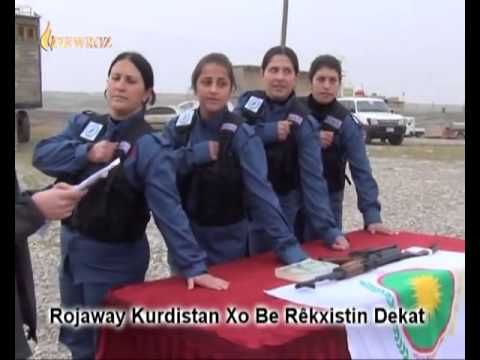 Image from Esteban Rivera, 3 July 2014
Image from Esteban Rivera, 3 July 2014
I forgot to mention one more flag featured in this video (3:26 and 4:38). It is the flag of the Kurdish Supreme Committee. They even had a poll or flag contest: "On its official Facebook page, the Kurdish Supreme Committee (KSC) posted a number of sample flags and logos as potential symbols to represent the unity of Syrian Kurds and different political factions working together under the umbrella of the committee."
Sources: Web Archive File, The Proposals, Northern Iraq Forum and this YouTube video.
It seems that this flag is actually the Asayish (Police Force) flag. So this flag remains an UFE.
Esteban Rivera, 3 July 2014
The three flags featured in this entry are also seen in this other section "Unidentified Kurdish Flags" as well and even (incorrectly displayed here, a mistake which I will approach in another follow up message), have been positively identified.
From left to right, the flags are:
1. Öcalan (leadership flag), which is part of the PKK.
2. YPJ ( Women's Protection Units or Women's Defense Units (Yekîneyên Parastina Jin, YPJ) (official website) which is part of the Syrian Democratic Forces. A GIF of the flag (which is actually a pennant) is seen here (source)
3. Kongreya Star (Congress Star), founded in 2005 under the name of Yekîtiya Star (Star Union of Women), a confederation of women's organizations in Rojava, Syria. The organization focuses on organizing women's communes which focus on economic opportunity and development, consciousness-raising and self-defense for women. Ideologically they are within the wider framework of the Democratic Confederalism (also known as Apoism, or democratic federalism) modernization movement. "Yekîtiya Star has established several academies, of which Yekîtiya Star Academy was founded in 2012 and provides instruction
through the framework of Jineolojî (Kurdish for "women's science"), a term coined by Abdullah Ocalan. The Academy offers an introduction to Jineolojî, an exploration of the economy from a feminist lens in which women are seen as central actors in the economy, civics as practiced in Rojava as well as other subjects". An image of the flag is seen here. (source)
Esteban Rivera, 13 March 2018
In these phrases, the word "star" is borrowed from English, although Kurdish for "star" is the very similar "_stêr / ئە".
I'd say that the term coined by Abdullah Ocalan is a Hellenic erudicism akin to the names of many medical specialties and academic disciplines, apparently "gyne+(o)+logy", which would trivially yield "Gyneology" in English.
António Martins, 14 March 2018
[This discussion continues at UFE22-56. "Unknown Kurdistan Flag" page. - Ed.]
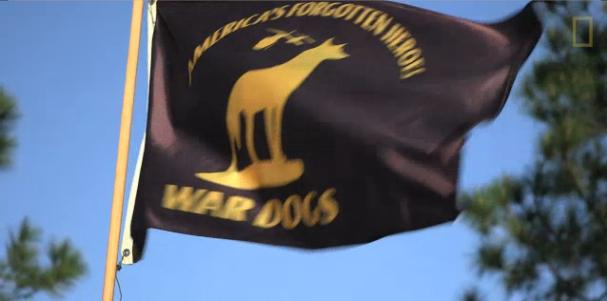
The War Dog flag has been moved to US Military Veteran Commemorative Flags.
These have been positively identified as the house flags of the Micoperi Company and Titan Salvage, which were placed above the bridge after the ship was sucessfully raised.
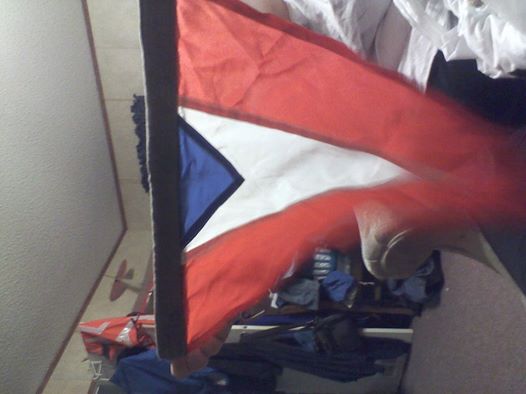 Image from Leah Patton, 30 July 2014
Image from Leah Patton, 30 July 2014
I purchased this flag it in Galveston, Texas, in the bin at at an Army-Navy surplus store that my family has frequented for many years. They are going out of business. No one there knew anything about the flag's meanings. I know it is not a letter, number, number pennant, repeater, convoy, or other International code. I begin to suspect, after seeing some "Port of" flags printed in the back of a very old nautical manual, that it might be a "Port of ????" pennant.
I have used the keywords Chevron, inset chevron, pennant, burgee, and, of course come up with more hits for party flags that anything. I have also posted for VURD on Facebook, but no takers there either.
Leah Patton, 30 July 2014
If I knew whom to ask, I would be interested in this very old nautical manual that apparently has Port flags of some kind in it. I wonder how large this flag is. If the hoist triangle was bigger, several designs of yacht club burgees would be similar, except they all have a charge of some kind, as if they are trying to avoid looking like this one. But it too much larger it would more likely be a signal of some kind.
Peter Hans van den Muijzenberg, 12 August 2014